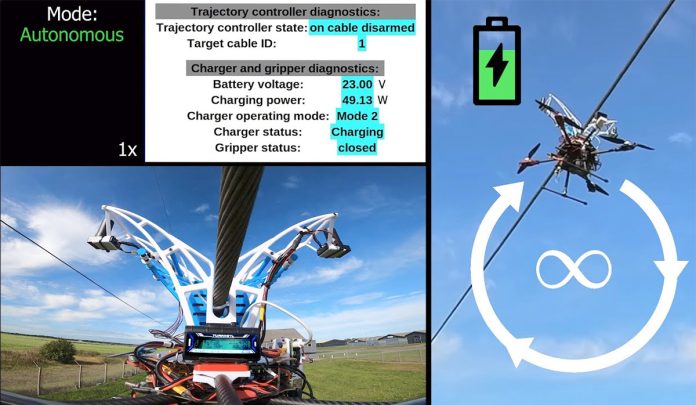In the rapidly evolving world of drone technology, a new development promises to significantly enhance the operational longevity of quadcopters. Researchers from the University of Southern Denmark have introduced an experimental quadcopter capable of recharging itself by attaching to power lines. This innovative feature could potentially allow drones to remain airborne indefinitely, dramatically increasing their utility in various applications.
The primary motivation behind this advancement is to aid autonomous drones tasked with inspecting power lines. Given that these drones operate in close proximity to their power sources, the ability to recharge directly from the lines themselves is both logical and convenient. The technology was developed by a team led by Viet Duong Hoang, utilizing a commercially available Tarot 650 Sport carbon fiber drone frame as the base for their modifications.
To achieve this capability, the drone was equipped with a specialized electric quadcopter propulsion system, powered by a 7,000-mAh lithium-polymer battery. Key components included a Raspberry Pi 4 B microcomputer for processing, a Pixhawk V6X autopilot module for navigation, and a combination of a millimeter-wave radar unit and an RGB video camera for detecting power lines. A critical innovation is the drone’s passively actuated power-line-gripper, designed to securely attach to power lines for recharging.
The gripping mechanism operates through a simple yet effective process. When the drone detects a low battery level, it identifies the nearest power line using its onboard camera and radar. It then ascends vertically until it reaches the line, at which point the line is guided into the gripper between two elastomer ribbons. This action causes the gripper to close securely around the line, enabling the drone to recharge via an inductive charger located on top of the unit.
Notably, the drone requires only a minimal amount of thrust to engage the gripper, and the voltage from the power line can power the control circuit directly if sufficient; otherwise, the drone’s battery provides the necessary power. This capability was demonstrated successfully in field tests conducted at Denmark’s HCA Airport, where a 4.3-kg drone managed to recharge its battery five times during a two-hour flight, all while performing line inspections.
The research team is focused on further enhancing the system’s robustness and testing it under a variety of conditions, including remote locations and adverse weather. Their research paper is set to be presented at The 2024 IEEE International Conference on Robotics and Automation, highlighting its significance in the field of robotics and automation.
This development represents a significant step forward in drone technology, offering promising applications not only in power line maintenance but also in any field requiring prolonged drone operations. As the technology matures and becomes more widely available, it could redefine the capabilities and efficiency of drone-based services across industries.
Source: University of Southern Denmark



